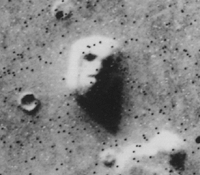Pareidolia (nonfiction): Difference between revisions
Jump to navigation
Jump to search
No edit summary |
No edit summary |
||
| Line 4: | Line 4: | ||
== Fiction cross-reference == | == Fiction cross-reference == | ||
* [[Gnomon algorithm]] | |||
* [[Gnomon Chronicles]] | |||
* [[Pareidolia Follies]] | |||
== Nonfiction cross-reference == | == Nonfiction cross-reference == | ||
Revision as of 10:40, 12 October 2018
Pareidolia (/pærɪˈdoʊliə/ parr-i-DOH-lee-ə) is a psychological phenomenon in which the mind responds to a stimulus, usually an image or a sound, by perceiving a familiar pattern where none exists (e.g., in random data).
Common examples are perceived images of animals, faces, or objects in cloud formations, the Man in the Moon, the Moon rabbit, hidden messages within recorded music played in reverse or at higher- or lower-than-normal speeds, and hearing indistinct voices in random noise such as that produced by air conditioners or fans.
Fiction cross-reference
Nonfiction cross-reference
External links:
- Pareidoila @ Wikipedia
- Artist Kyle Kesterson draws the faces he sees in things @ Boing Boing
